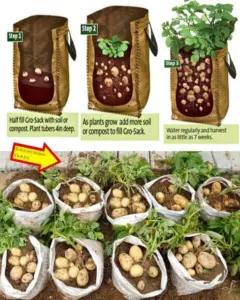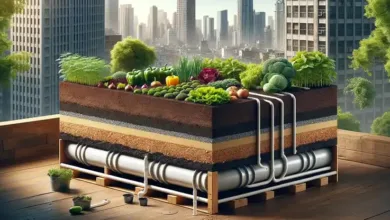How To Grow Sacks Full Of Potatoes – 6 Weird Ways That Really Work
How To Grow Sacks Full Of Potatoes – 6 Weird Ways That Really Work 💥🥔💬👇
Well, I’ll be honest. You might not think so at first but there are many great reasons to grow potatoes in your garden!
I know it seems like they’re fairly inexpensive and that the taste won’t be much different from what you can buy anywhere else–but believe me-they’ve got some surprises up their sleeve when it comes to nutrition!
For those who love to garden, there’s no question that potatoes are an essential ingredient.
But how do you grow them in the first place? Well it turns out these mysterious plants actually have some rather unusual requirements!
However, with just a little creativity and imagination (not forgetting plenty of love) anyone can turn their potato patch into something really impressive!

- Pounds of Potatoes in 4-Square Feet
A few tips for getting the most out of this technique:
Start early or risk not having enough sunlight on when you want it. It should be around April, and late August.
Take about 3 months before harvesting so that all necessary nutrients can build up in there properly.
To get the best potatoes, don’t cut your seed potatoes. Make sure there are two eyes on each part you plant, and dust the cut pieces to help seal out bacteria!
Use 10-20-20 fertilizer when planting to provide nutrients for healthy plants all season long as well as just before harvesting, so they taste better at their crunchiest consistency possible! Water well to maintain even moisture. Avoid planting in consecutive years if possible!
If you’re short on space, build a box and plant inside of it. You can add sides to the box as its grows so that when your potatoes grow out too far or need more room for vegetation, you can simply pull them out and leave room for new potatoes.
2. Trash Bag Potatoes
Growing potatoes in a trash bag is virtually foolproof and it only takes a couple of easy steps to do so.
One week before planting, put your seed potatoes in a warm spot. When sprouts that are about one-quarter inch to half an inch long form on them, they’re ready for the garden! Cut big spuds into chunks: 2 inches wide is perfect (and you can even cut more if there’s space) with at least two healthy shoots emerging from each piece–then let it sit out at room temperature overnight.
Use a pair of scissors to make drainage holes in the bottom of your 30-gallon trash bag. Then fill it with about one third potting soil, roll up both sides and place where full sunlight is able to reach it!
Potato plants require a lot of water and fertilizer. First, spread agricultural sulfur on the soil around newly planted potato seeds to protect them against fungal disease. Then plant them about two inches deep or just enough so that their eyes are visible above ground level when they grow up later; make sure you thoroughly water these babies before planting!
To keep your potato plants thriving, make sure they have all the necessary nutrients. To do this add a little more soil and straw when the plant is 6-8 inches tall and continue to unroll as it grows even further in height!
Now comes the fun part: harvesting time! Your potatoes are ready for harvest when they have turned yellow and their leaves die back. At this point, stop watering them so that you don’t disrupt this natural process. Simply leave them alone in an un-watered state over a few weeks to allow their skins to toughen up before harvesting. Do this by slitting open one side of your bag or container with scissors and releasing your potatoes.
3. Commercial Grow Bags
Commercial grow bags can be a great option for those who want to increase their crop yield. Made of heavy, dense polypropylene they typically last several seasons before needing replacement with an upgraded model or new bag.
To use them simply place four seed pieces into the bottom layer and cover up by three inches of soil mix; continuing adding more until your entire volume has been filled. When you are ready to harvest, just flip it over onto its side and release the potatoes!
Plant potatoes in the ground (8-12 inches apart) and keep them covered with straw. Add 3-4 inches of loose straw.
As they grow, top-dress them until you have one foot of loose soil or more on top for each plant. Make sure to water deeply when it gets hot during summer months so that they can survive here!
4. Bucket Potatoes
What you’ll need:
- A bucket (if you can, get a 5-gallon bucket)
- Small rocks or pebbles
- Potting soil
- A black trash bag
- Seed potatoes
To make sure you have proper drainage, add rocks or pebbles to the bottom of your bucket. Cover it with 1 inch – 2 inches for best results!
By opening the garbage bag and inserting it inside the bucket, you may attach it to the bucket. It should have about a one-inch overhang when cut. Make a cut with your scissors to mark it, then lay the garbage bag over the floor.
Draw a straight line from the bag and re-insert it into the bucket. About twenty drainage holes should be poked out.
Once the trash bag is inside, add 4-5 inches of potting soil in the bottom of the bucket. Then, place all your potatoes, but make sure you add three potatoes on top of the soil.
Make sure to give them plenty of water, then watch as your crop grows!
The potatoes are ready for harvest once the leaves begin yellowing and die back.
5. Wire Cage
You can also grow potatoes easily using a piece of wire stock fence rolled into an easy to manage cage. It only takes minimal effort and your plants will thank you for it!
For this method, you will need:
- A 10-foot-long wire stock fence or other durable wire fence
- Potatoes from seed
- Fertilizer
When cutting your fence, make sure you cut it into a 10-foot long piece and then roll up the pieces until they are three feet wide.
Fasten this end with wire so that when fastened together tightly enough for stability on top of each other it becomes five feet high!
Make sure you have prepared your soil before planting by loosening it up and adding in some fertilizer.
This will help get the potatoes off on a good start! Plant them about 3 to 4 inches deep, then hand tamp around them so that they’ve secured themselves into their new home.
Next, place your wire hoops so that they stand upright. Set them up around the seed potatoes you’ve planted in an area where there’s enough room for all of them to grow well and be healthy, while not crowding each other out or touching any obstacles on their way through growth stages such as fences or walls.
You want this space filled with straw when sprouting begins because it’s important leaves don’t get buried too far below- just two -three inches max!
When your potato plants are about a foot tall, cover them up completely with straw or leaves.
As they grow and need more soil to produce potatoes in the cylinder that is being filled as you go along – keep filling it up without worrying if its too much; just make sure there’s enough water so as not to drown those little shoots!
6. Potato Tire Tower
More and more people are using old tires for growing all sorts of things, including potatoes.
All you have to do is wash them thoroughly to get rid of any road grime from it firs. This eco-friendly way can help re-purpose your garage or yard while providing food in an effortless manner!
To create the perfect home for your potatoes, lay down a tire and fill it with soil.
Make sure the space you put it in gets lots of sunshine. Plant two seed pieces of potato around the edge so that each piece has eyes facing up!
When you add another tire, cover it with soil. Keep the top four or five leaves poking out and continue to grow your potatoes in this manner (keep adding tires and soil) until they reach maturity!
Harvesting potatoes is a laborious process, but the rewards are well worth it.
First, you have to remove any yellow leaves from your plant and then carefully take out each tire until all soil has been removed from around them, so they can dry completely before they’re ready to be consumed.







